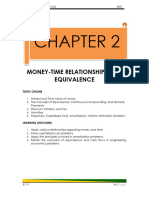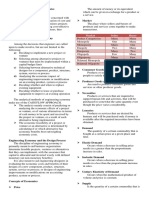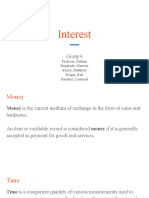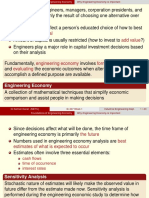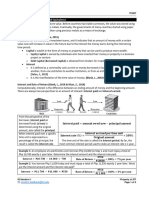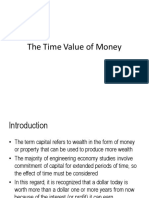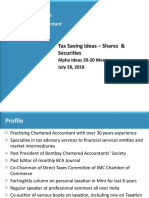ENGINEERING
ECONOMICS
�ENGINEERING ECONOMICS 2020
ENGINEERING ECONOMICS
PERCY T. GASCON
VASCO VIC G. VALDEZ
College of Engineering
Civil Engineering Department
2020
IE 111 2|Pag e
�ENGINEERING ECONOMICS 2020
CHAPTER 02: MONEY-TIME RELATIONSHIPS AND EQUIVALENCE
LESSON 01: Interest and
the Time Value of Money
The cash flow is fundamental to every economic study. Cash flows occur in
many configurations and amounts isolated single values, series that are uniform,
and series that increase or decrease by constant amounts or constant percentages.
This chapter develops derivations for all the commonly used engineering economy
factors that take the time value of money into account.
Interest is the amount of money paid for the use of borrowed capital or the
income produced by money which has been loaned.
Elements of Transactions Involving Interest
Many types of transactions involve - e.g., borrowing money, investing money,
or purchasing machinery on credit but certain elements are common to all types
of these types of transactions:
1. The initial amount of money invested or borrowed in transactions is called the
principal (P).
2. The interest rate (i) measures the cost or price of money and is called the
percentage per period of time.
3. A specified length of time marks the duration of the transaction and thereby
establishes a certain number of interest periods (n).
4. A plan for receipts or disbursements that yields a particular cash flow pattern
over a specified length of time. (For example, we might have a series of equal
monthly payments that repay a loan.)
5. A future amount of money (F) results from the cumulative effects of the
interest rate over a number of interest periods.
The Time Value of Money
The time value of money seems like a sophisticated concept, yet it is one that
you grapple with every day. Should you buy something today or save your money
and buy it later? Here is a simple example of how your buying behavior can have
varying results: Pretend you have Php 5, 000 and you want to buy a Php 5, 000
refrigerator for your dorm room. If you buy it now, you end up broke. But if you invest
your money at 6% annual interest, then in a year you can still buy the refrigerator, and
you will have Php 300 left over. However, if the price of the refrigerator increases at
an annual rate of 8% due to inflation, then you will not have enough money (you will
be Php 100 short) to buy the refrigerator a year from now. In that case, you probably
IE 111 3|Pag e
�ENGINEERING ECONOMICS 2020
are better off buying the refrigerator now. If the inflation rate is running at only 4%,
then you will have Php 100 left over if you buy the refrigerator a year from now
Clearly, the rate at which you earn interest should be higher than the inflation
rate in order to make any economic sense of the delayed purchase. In other words,
in an inflationary economy, your purchasing power will continue to decrease as you
further delay the purchase of the refrigerator. In order to make up this future loss in
purchasing power, the rate at which you earn interest should be sufficiently larger
than the anticipated inflation rate. After all. time, like money, is a finite resource. There
are only 24 hours in a day, so time has to be budgeted, too. What this example
illustrates is that we must connect earning power and purchasing power to the
concept of time.
The way interest operates reflects the fact that money has a time value. This is
why amounts of interest depend on lengths of time; interest rates. for example, are
typically given in terms of a percentage per year. We may define the principle of the
time value of money as follows: The economic value of a sum depends on when the
sum is received. Because money has both earning power and purchasing power over
time (i.e., it can be put to work, earning more money for its owner). a dollar received
today has a greater value than a dollar received at some future time. When we deal
with large amounts of money, long periods of time, or high interest rates, the change
in the value of a sum of money over time becomes extremely significant.
When financial institutions quote lending or borrowing interest rates in the
marketplace, those interest rates reflect the desired earning rate, as well as any
protection from loss in the future purchasing power of money because of inflation.
interest rates, adjusted for inflation, rise and fall to balance the amount saved with the
amount borrowed, which affects the allocation of scarce resources between present
and future uses.
Simple Interest
Simple interest is calculated using principal only, ignoring any interest that had
been accrued in preceding periods. In practice, simple interest is paid on short-term
loans in which the time of the loan is measured in days.
Where:
I = interest
P = principal or present worth
n = number of interest periods
i = rate of interest per interest period
F = accumulated amount or future worth
Ordinary simple interest is computed on the basis of 12 months of 30 days each or 360
days a year.
one interest period = 360 days
IE 111 4|Pag e
�ENGINEERING ECONOMICS 2020
Exact simple interest is based on the exact number of days a year, 365 days for an
ordinary year and 366 days for a leap year.
one interest period = 365 or 366 days
ILLUSTRATIVE PROBLEMS
1. Supposed you deposit Php 1, 000 in a bank savings account that pays interest
at a rate of 8% per year. Assum
at the end of each period (year), but instead let it accumulate. How much
would you have at the end of year three with simple interest?
Solution
Given: P = Php 1, 000.00
n = 3 years
i = 8% per year
2. Determine the ordinary simple interest on Php 700 for 8 months and 15 days if
the rate of interest is 15%.
Solution
Number of days = (8)(30) + 15 = 255 days
3. Determine the exact simple interest on Php 500 for the period from January 10
to October 28, 1996 at 16% interest.
Solution
1996 is a leap year
January 10-31 = 21 (excluding Jan. 10)
February = 29
March = 31
April = 30
May = 31
June = 30
July = 31
August = 31
September = 30
October = 28 (including October 28)
Total = 292 days
IE 111 5|Pag e
�ENGINEERING ECONOMICS 2020
4. What will be the future worth of money after 15 months, if a sum of Php 10,
000.00 is invested today at a simple interest rate of 12% per year?
Solution
Cash Flow Diagrams
A cash-flow diagram is simply a graphical representation of cash flows drawn
on a time scale. Cash-flow diagram for economic analysis problems is analogous to
that of free body diagram for mechanics problems.
Receipt (positive cash flow or cash inflow). Cash inflows are the receipts,
revenues, incomes, and savings generated by project and business activity. A
plus sign indicates a cash inflow.
Disbursement (negative cash flow or cash outflow). Cash outflows are costs,
disbursements, expenses, and taxes caused by projects and business Cash flow
activity. A negative or minus sign indicates a cash outflow. When a project
involves only costs, the minus sign may be omitted for some techniques, such
as benefit/cost analysis.
A loan of Php 100.00 at simple interest of 10% will become Php 150.00 after 5
years.
IE 111 6|Pag e
�ENGINEERING ECONOMICS 2020
Cash flow diagram on the viewpoint of the lender
Cash flow diagram on the viewpoint of the borrower
COMPOUND INTEREST
In calculations of compound interest, the interest for an interest period is
calculated on the principal plus total amount of interest accumulated in previous
periods. Thus,
IE 111 7|Pag e
�ENGINEERING ECONOMICS 2020
In compound interest, the interest earned by the principal at the end of each
interest period (compounding period) is added to the principal. The sum (principal +
interest) will earn another interest in the next compounding period.
Compound Interest (Borro
Interest Principal at Interest Earned During Amount at End of Period
Period Beginning of Period Period
1 P Pi P+Pi = P(1+i)
2 P(1+i) P(1+i)i P(1+i) + P(1+i)I = P(1+i)2
3 P(1+i)2 P(1+i)2i P(1+i)2 + P(1+i)2i = P(1+i)3
n P(1+i)n-1 P(1+i)n-1i P(1+i)n
Where:
P = principal, present amount
F = future amount, compound amount
i = interest rate per compounding period
r = nominal annual interest rate
n = total number of compounding in t years
t = number of years
m = number of compounding per year
The quantity (1+i)n
F = P(F/P, i%, n)
The symbol F/P i
The quantity (1+i)-n
and is designated by the functional symbol P/F, i%,n. Thus,
P = F(P/F, i%, n)
The symbol P/F P given F
Rates of Interest
a. Nominal Rate of Interest
The nominal rate of interest specifies the rate of interest and a number of
interest periods in one year.
IE 111 8|Pag e
�ENGINEERING ECONOMICS 2020
Where: i = rate of interest per interest period
r = nominal interest rate
m = number of compounding periods per year
If the nominal rate of interest is 8% compounded quarterly, then i = 8%/4 = 2%,
the rate of interest per interest period.
b. Effective Rate of Interest
Effective rate of interest is the actual or exact rate of interest on the principal
during one year. If Php 1.00 is invested at a nominal rate of 15% compounded
quarterly, after one year this will become.
The actual interest earned is Php 0.1586, therefore, the rate of interest after
one year is 15.86%. Hence,
Effective rate = F1 1 = (1+i)m 1
Where F1 = the amount Php 1.00 will be after one year.
Effective Rate of Interest
ILLUSTRATIVE PROBLEMS
1. Supposed you deposit Php 1, 000 in a bank savings account that pays interest
at the end of each period (year), but instead let it accumulate. How much
would you have at the end of year three with compound interest?
Solution
Given: P = Php 1, 000.00
n = 3 years
i = 8% per year
IE 111 9|Pag e
�ENGINEERING ECONOMICS 2020
2. Find the nominal rate which if converted quarterly could be used instead of
12% compounded monthly. What is the corresponding effective rate?
Solution
Let r = the unknown nominal rate
The effective rate at r% compounded quarterly:
The effective rate at 12% compounded monthly:
For two or more nominal rates to be equivalent, their corresponding effective
rates must be equal.
3. Suppose that the interest rate is 10% per year, compounded annually. What is
the minimum amount of money that would have to be invested for a two-
year period in order to earn Php 15, 000.00 in interest?
Solution
i = 10% compounded annually
Interest in two years = 15, 000.00
F = P + 15, 000.00
If the principal or present worth is to be computed we use the formula,
Substitute the given items to the equation
IE 111 10 | P a g e
�ENGINEERING ECONOMICS 2020
4. If Php 3, 000.00 is placed in an account at 5% and is compounded quarterly
for 5 years. How much is the account at the end of 5 years?
Solution
Given:
P = Php 3, 000.00
r = 5%
m = 4 (quarterly)
t = 5 (years)
5. A Php 200, 000.00 loan was originally made at 8% simple interest for 4 years. At
the end of this period the loan was extended for 3 years, without the interest
being paid, but the new interest rate was made 10% compounded
semiannually. How much should the borrower pay at the end of 7 years?
Solution
Draw the cash flow diagram
For the first four years, the simple interest is 8%. Compute for F4 using simple interest
formula
IE 111 11 | P a g e
�ENGINEERING ECONOMICS 2020
For the last 3 years, use compound interest at 10% compounded semiannually.
Here, i = 0.05 since it is compounded semiannually. 10% is divided by 2 since the
payment is done twice a year. The value of n = 6 because in 3 years there will be a
total of 6 payments since payments are made twice a year.
IE 111 12 | P a g e

